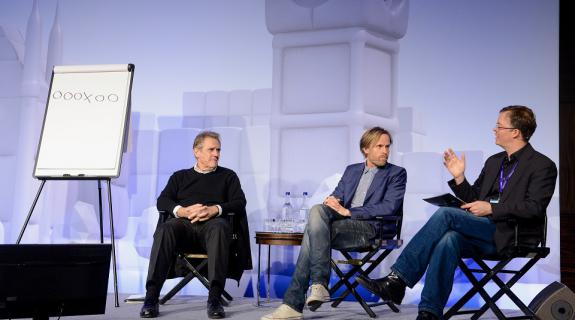Navy designer Kelly Johnson first coined the term “Keep it Simple, Stupid,” back in 1960. In today’s complex media world, that concept applies even more today.
“Simplicity is the most valuable thing,” said Filip Nilsson, international creative director, EVP, Havas’ BETC. Last June, he joined BETC from the only firm he’s ever worked for: Swedish agency Forsman & Bodernfors.
“Strategy is sacrifice,” said Dave Trott, chairman of The Gate London. “The whole job is to keep reducing it until you can’t reduce it anymore.”
The two creative legends offered these insights during the Visions of Creative Leadership panel at PromaxBDA Europe 2014. Clark Parsons, co-managing director of The Berlin School of Creative Leadership, moderated.
Beyond keeping campaigns and messages simple, Nilsson and Trott agreed that the work has to feel completely different from anything else out there.
When asked how to motivate employees to do world-class work, Trott said: “I don’t think it’s about being better, it’s about being different. If you want to grow, you have to decide whether to grow the market or take share. In order to take share, you have to be different.”
Nilsson also offered these six insights about creative leadership:
1. Challenge everything. “Most agencies are organized in the same way that agencies were organized in 1947 and it’s not very impressive,” said Nilsson.
2. Minimize prestige. “The only way people will share stuff with people around them is if they feel safe, if they trust them,” Nilsson said. “Try to get the best people, make them work really hard and then make them open up, make them take in input from the people around them.”
3. Minimize hierarchy. Maximize leadership.
4. Keep Moving. What’s the next stop? “When we decided to focus on digital and have digital at the heart of the agency, that really kept us moving for several years,” Nilsson said.
5. Create Crisis. Stay uncomfortable.
6. Live in a paradox of humanistic elitism.
That last concept sounds tricky but Nilsson illustrated it with a picture of Jesus Christ contrasted with a picture of Donald Trump. “We are trying to combine those two worlds,” Nilsson said, to create work and a workplace that is warm and embracing but still feels elite.
Trott added a few things to that list. First of all: hire hungry people who will work harder than anyone else.
“I always liked to hire young people because they are very keen and very desperate,” Trott said. “But I never hired them straight out of college because they are too cocky. I would wait until they had been out of it a couple, three years. When their career is stalled and they’re desperate, that’s when you hire them. If people have the energy and the desperation, then I can provide the rest.”
Trott told a story that both sounds fresh out of AMC’s “Mad Men” and illustrates how he climbed his way to the top. When he was a junior trade advertising executive in London, he would stay after work and then sneak around to the senior executives’ desks and steal the TV briefs off their desks. He would then go write up proposals for those briefs and present them in the morning. That’s how he got himself moved off of trade advertising and on to TV.
In general, Trott has a take-no-prisoners approach to his chosen craft. Asked “how much freedom do you give people to fail?” he said: “If you fail you fail, and you get your ass kicked. This is tough guy stuff. This is the one chance in your life when you can be the best you can be. For one time in your life, you want to play flat-out 24/7. It takes more to be on the best team than it does to be on the other teams. If you are afraid of failure, you can go play for one of the other teams.”
In the end, running world-class teams means not being afraid – of failure, of risk, of hard work, even of being upstaged by the hungry young executives you’ve hired.
Said Trott: “I know I’ve got the right team in place when I can no longer earn a spot on it. I want people on my team who can do better work than I can do.”
Photo caption: Dave Trott, Filip Nilsson and Clark Parsons discuss concepts of creative leadership.
Image by Tom Howard.
Tags:













































__twocolumncontent.jpg)










